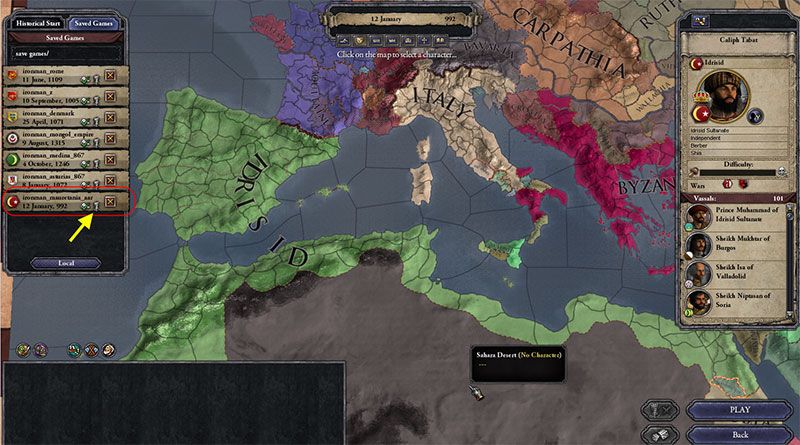
Red Crescent - The Sultan of Mauretania's bid for Hispania
- Thread starter TinMann
- Start date
-
We have updated our Community Code of Conduct. Please read through the new rules for the forum that are an integral part of Paradox Interactive’s User Agreement.
You are using an out of date browser. It may not display this or other websites correctly.
You should upgrade or use an alternative browser.
You should upgrade or use an alternative browser.
| September 1, 932: Andalusia aflame | |

Keraja led more than twenty thousand fresh troops into Andalusia that September against only marginal resistance. One enemy army of about three thousand battle-weary souls was pounced upon and dispatched at the Battle of Zaragoza before Mauretania’s adversary retired from the field altogether. Although Andalusia had no hope of victory, still Caliph Mansur stubbornly defended his holdings to the last man. Keraja pleaded with him to surrender and stop the slaughter, but it was not to be. Keraja was forced to wade through rivers of mud and blood to force an end to the conflict, taking Caceres in July of 933, Badajoz by that August, Plascencia in December, and finally Alcantara in January 934. On January 23 of 934 Mansur finally relented. | 
|
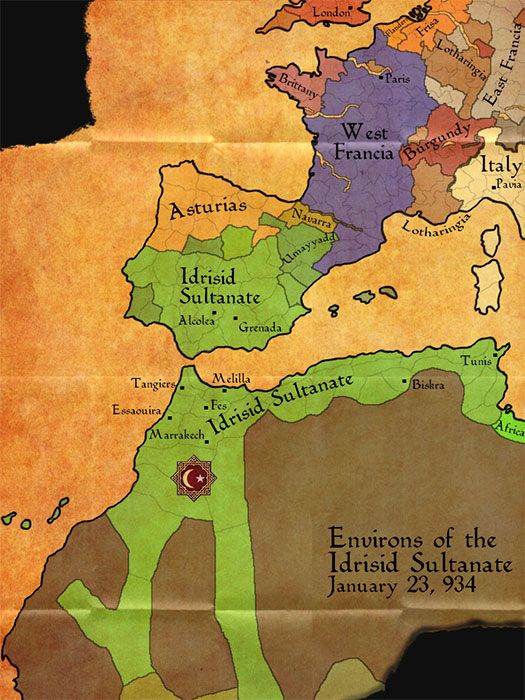
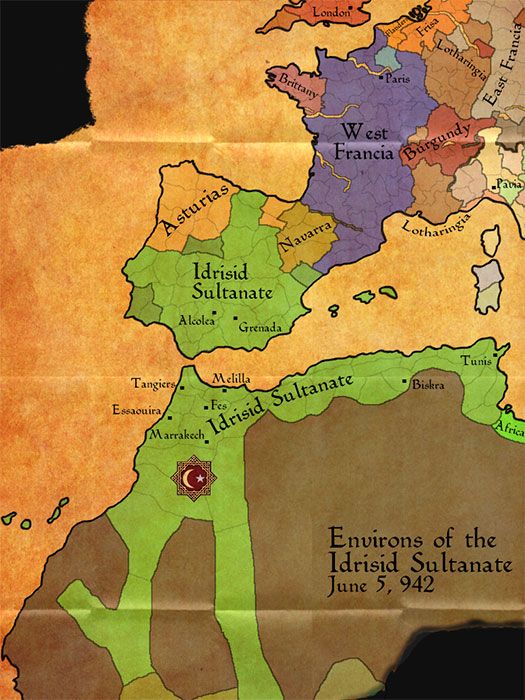
| The brutal, unnecessary war left Caliph Keraja disillusioned. He genuinely wanted to help his fellow Muslims in Andalusia, but was forced to starve and slaughter them in droves, in order to keep the Christians from starving and slaughtering them. The cruel and unfair nature of the world came into sharp focus during this time and weighed heavily on him. As a result, the optimistic young leader who believed diplomacy could right all wrongs became a grizzled realist. He decided that if the people of the Iberian Peninsula would not submit to his rule, then he would subjugate them by force – no matter what their religion. Keraja no longer saw himself as a protector, but rather as a conqueror. He set out to accomplish this task with brutal efficiency through a number of holy wars launched in rapid succession In April of 934 the lands of the independent Sheikh Muslihiddin of Deniyya were incorporated into the realm. In September Emir Umar’s Qaysid Emirate in Valencia was also conquered. Prince Mirza, former Sultan of Andalusia, had his lands in Valladolid annexed in February of 935. Mallorca was absorbed into the realm in December of 936. Following these conquests an uneasy peace settled over Mauretania, giving Keraja time to catch his breath. He rededicated himself to his faith and achieved the title of Hafiz in 937, one bestowed upon those who have memorized the entire Qur’an. Domestically his fortunes could not have been better. Keraja shrewdly had replaced all Sunni leaders who would not convert with friendly Berber Shias. This allowed him to be almost universally loved and respected by vassals, so much so that his spymaster took up writing poetry for the lack of something to do. When his truce with King Alfonso expired in 937, Keraja once again declared war on him for the rich province of Castille in northern Hispania. This time his vassals did not object, allowing the Caliph to do what he felt was right. Alfonso’s army of 3,000 was joined with 9,500 from Brittany, the first indication that European leaders might start working together after all. Nonetheless, the war was short. The decisive Battle of Segovia ended the conflict when the Christians’ army was wiped out to a man, and Prince Fernando of Asturias was captured. This success was followed by another five years of peace. Now in his mid-thirties, Keraja took stock of his life and his accomplishments and realized that he did not like the person he had become. Instead of saving Andalusia from the flames, he was the one who had set it alight. The realization caused him to fall into a pervasive depression that was obvious to all around him. Around that time Keraja decided to move his capitol to Grenada, hoping a change of environment might help. It did not. He took some comfort in raising his two sons into promising young leaders. His spirits sank into near despondency when his beloved Kit passed away in 941 from small pox. A year later a sense of mission finally returned to him, drawing him somewhat out of his darkness. Navarra, the small Basque nation along the western end of the Pyrenees, had succeeded in wrestling the provinces within the Aragorn region from the Umayyads. Overnight they had become a regional presence, and one without a truce with Mauretania. With renewed purpose Keraja immediately began drawing up plans for an attack. By that point his vassals went along without objection, now believing the nation under him was invincible. |
Last edited:
| July 1 942: To the Pyrenees | |

King Joanes ‘The Just’ of Navarra was quickly joined by King Per of Brittany and Alfonso of Asturias in the defense of Aragorn. Not long after hostilities began both of Keraja’s sons reached their majorities. The elder, Keraja (one day to be Caliph Keraja II), had had all the trappings of a great diplomat. Several small engagements with the Christians culminated in the Battle of San Pedro de Perix, where the enemy’s combined army was annihilated and King Alfonso himself captured. King Joanes surrendered the next day on March 10, 943. This victory was significant as it pushed the border of Muslim lands all the way to the Pyrenees Mountains, and the frontier with West Francia proper. Caliph Keraja seemed unstoppable in the eyes of his vassals and enemies alike. At the celebrations that broke out across Mauretania there was giddy talk about one day claiming all of Hispania. Keraja himself even gave into the celebratory spirit. In June of that year Emir Zeyd of Algarve became independent of Sultan Masur, and was annexed into Mauretania through another brief war. In February of 944 the truce with Mansur ended and Keraja took his last holding in Valencia. In August of 947 the new King of Asturias, Marin, declared a holy war on the last remaining Umayyad holding, Salamanca. As before, the now aged Sultan Mansur refused Keraja’s help. Exasperated at his lack of options, Keraja prepared his men for a counter-invasion once the Umayyads had been wiped off the map. This was not long in coming. In 948 Keraja declared war on them to liberate the Sunnis in Leon. The campaign was brief, culminating in the Battle of Villablino in September. Asturias surrendered immediately following. At this point in his life the dark shroud that had hung over Keraja’s personality began to lift. Over several long talks, his wise and aged courtier, the 77-year | 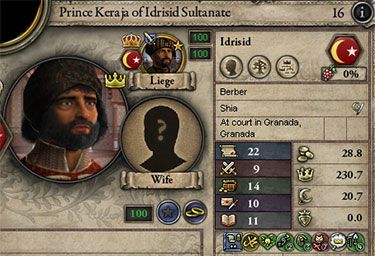
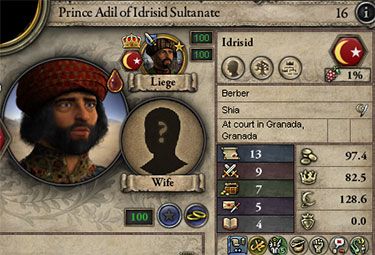
|
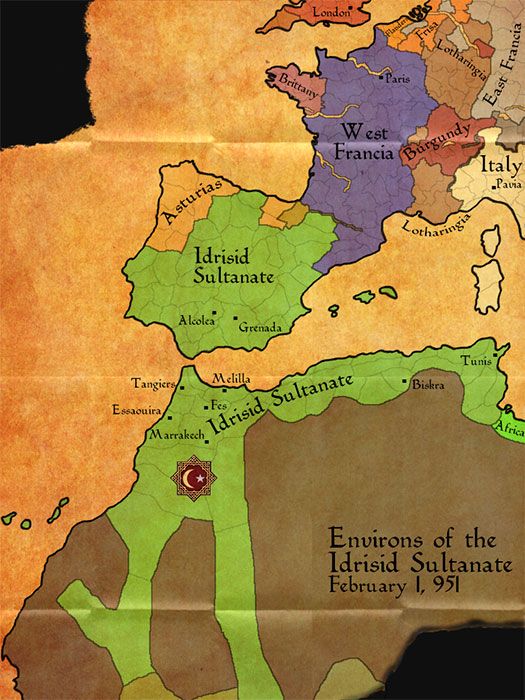
| old Myassa bint Aflah (daughter of the late Emir Aflah of Tlemcen) convinced Keraja that his life’s work had been an important and resounding success. Over time his depression lifted through Myassa’s kind counsel. Inspired by Myassa, he decided that his work was not yet complete. Now 48 years old, Keraja determined that he could not rest until West Francia had been removed from all parts of Aragorn. To that end he decided to embark on what would be the last major campaign of his reign. Plans were made for an attack on the largest enemy the Sultanate of Mauretania had ever faced: The French. War was declared on February 1 of 951. The Holy War for Barcelona began without much opposition, with Tarragona falling in June. In August the first pitched battle took place – the Battle of Barcelona. Ten thousand Frenchmen under the command of Count Pepin attempted to relieve the siege of Barcelona, being conducted by 9,600 Mauretanians under Sheikh Isa of Valladolid. As soon as word was received of the impending battle, twelve thousand Mauretanians under Caliph Keraja abandoned the siege of Alberracin and raced to the coast to assist. They joined the main force on the fourth day of combat. The bloodbath lasted for a full week before fate favored the superior force. The French were routed to Lleida where they were finished off, with Count Pepin captured and Duke Savary of Toulouse slain in the process. Lleida fell in October followed by Urgell in December, prompting the French to surrender all of Barcelona on December 11th. In some circles, the victory over the French was seen as a vindication of the devastating loss at Tours so many years ago. Caliph Keraja was quite pleased, but chose to not give into the giddiness that filled his courtiers. Keraja knew this was the first war Mauretania had fought against the French, but it would be far from the last. |
Last edited:
| Chapter 2 Epilogue | |||||||||||||||||||||||||||||||||||||

Once Keraja returned to the business of administering his significant realm, he decided to institute new laws that would not allow any of his hard-fought territory to be removed from the realm through inheritances. It is ironic that his final act of statesmanship was one of the first things he promised not to do. While the change was unpopular, his status as a national hero overrode any negative impact. Soon after this declaration Keraja came down with a bad case of pneumonia. Weakened as he was from his recent exertions in Barcelona, he succumbed on June 23, 953. He was 50 years old. The public outpouring of grief was as profound as when his grandfather Yahya ‘The Bold’ passed. Mourners filled the streets of Grenada for the procession to his final resting place. His son, the 27-year old Keraja II, had some very significant shoes to fill. His victory over the French would be the highest of many high points during Caliph Keraja I’s reign. Having swept aside all opposition, undefeated in more than a dozen wars, Keraja exorcised the demons of Tours and thrust his nation onto the world stage. No longer was Mauretania considered a dusty, moderate power on the fringe of civilization. Thanks to Keraja and his forebears, Mauretania was now Europe and Africa’s superpower. Despite a series of bitter disappointments and depression in his personal life, Keraja managed to unite all of Islam west of Tripolitania, and claim the lion’s share of the Iberian Peninsula. A new and unexpected dawn had broken on Europe, and its Kings had doubtless taken notice. | 
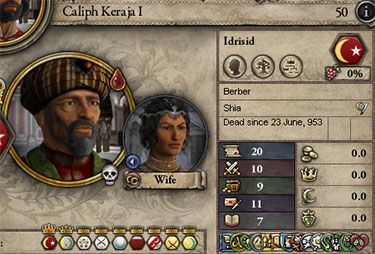
Caliph Keraja I at his death.
| ||||||||||||||||||||||||||||||||||||
| 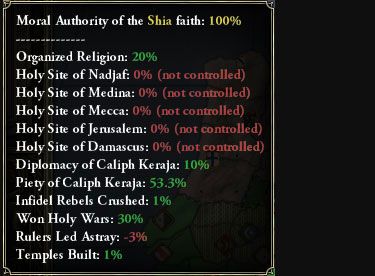
It's interesting to see how high moral authority can get with a pious religious leader, even if no holy sites are held. |
Last edited:
| Author’s Commentary Thanks to everyone for reading all this, for your words and encouragement – they are really appreciated! I’ve never played Mauretania before this run-through, so I had no idea I could move so quickly. I’ve blitzed through Mauretania playing other countries without much opposition, so I just assumed they would be pushover. Who knew? Anyways, I get the impression that Europe isn’t quite ready for the crusades, so it may be a while before I see any real external opposition. At this point the hard work is going to be holding Mauretania together. Since that isn’t as much fun to write about as expanding, I am considering options on what to do next to keep the dialog interesting. I would like to see how far I could get into Europe, but I think I will have a harder time without a permanently strong religious authority. So I’m toying with the idea of attacking eastwards to liberate the holy sites and set up some friendly neighbors in Africa before diving into France. My gut tells me that putting off France for a while may also be a good idea since Spain still needs to be digested. Since I don’t really know what I want to do yet, I’m holding off on forming the Empire of Hispania. If nothing else it will allow the duchies to continue to drift into Mauretania. In general my personal preference is to have one large kingdom title instead a bunch of little ones, since with multiple everybody wants one for themselves. Feel free to chime in with ideas or suggestions, and thanks again for reading! |
1. Take the entirety of Hispania.
2. Move southwards and place a West African Shia on the throne of Mali
3. Assemble a significant naval force, proceed to fight your way via the islands of the Mediterrenean until you have a reasonable basing point to hit Jerusalem & Arabia. Liberate those islands as independent emirates afterwards, leave allies on Jerusalem and Arabia along with your retinues (to deal with revolts during those fragile early years) while you try to fend of the French/Christian response on your own homelands.
2. Move southwards and place a West African Shia on the throne of Mali
3. Assemble a significant naval force, proceed to fight your way via the islands of the Mediterrenean until you have a reasonable basing point to hit Jerusalem & Arabia. Liberate those islands as independent emirates afterwards, leave allies on Jerusalem and Arabia along with your retinues (to deal with revolts during those fragile early years) while you try to fend of the French/Christian response on your own homelands.
Chapter 3: Reach for Empire June 23, 953: The Second Caliph Keraja | |

It’s never easy taking over the reins of power from a national hero. Keraja II understood this, and he also realized that he would likely spend the rest of his days trying to escape from his father’s shadow. Be that as it may, at least the 27-year old Caliph was more prepared for his role than his father had been when he ascended the throne. The first thing Kerja did was nominate his half-brother and heir, Prince Adil, to be his Grand Vizier and Chief Architect. Born four months apart and raised together by their father, the two were closer than most half-brothers. (Which is to say they didn’t hate each other.) Keraja even took on Adil’s nephew, Tabat, as a ward. Keraja hoped that they could face a potential succession crisis together as a team, and told him as much. His brother seemed amenable as he went about his expected duties. Planning for the worst, Keraja pulled his retinue from the frontier with Francia back to his capitol before undertaking the Hajj to Mecca. His brother served adequately as regent, and Keraja II returned to a land that was calm. It was obvious, though, that many wished to repeal the laws instituted by the previous two Caliphs. Still, the brothers watched and waited to see if anything would come of the grumblings. By October of 956 no succession issues had emerged and Keraja felt confident enough to continue consolidating Hispania. A holy war was called on King Martin of Castille for the Emirate of Navarra. Unfortunately and to everyone’s great surprise, while on the campaign Keraja took sick and died with his army besieging Najera. Keraja II did not reign long enough to leave much of a legacy, other than a positive impression on his people. At least his successor would not need to accomplish much to outshine him. Services for Caliph Keraja II were postponed until after the war for Navarra was concluded. | 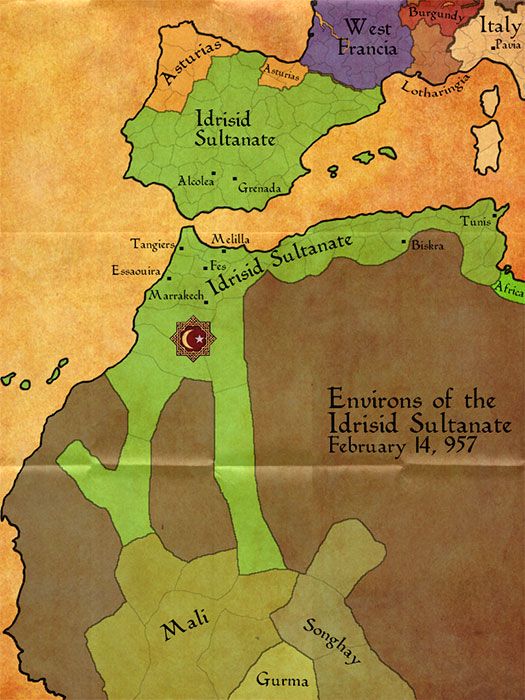
|
Last edited:
| February 14, 957: The second Caliph Adil | |

To his great surprise Prince Adil had become Calph Adil II without even being aware that his brother was ill. His investiture in Grenada was rushed so that he could take his half-brother’s place leading the army in Navarra. Adil had never planned on taking over the Caliphate, and frankly he wasn’t sure if he wanted the job. Furthermore, it could not have come at a worse time with his army engaged in a foreign war. He agreed with his council that the war needed to end quickly to free up the army to deal with any internal issues that might arise. Najera fell in May of 957. Adil led the traditional left flank as his army of 15,000 later marched on Asturias de Santillana to meet the enemy’s combined force of 3,500. They soundly defeated the smaller army and chased the remnants all the way to Navarra before King Martin surrendered on July 4, 957. Afterwards, Adil immediately set off for Mecca while his army headed back to the capitol. His counselors had advised against it, but since the days of Yahya II it had become tradition for a new Caliph to undertake the Hajj, and so he did. The pilgrimage went smoothly and he returned in short order. | 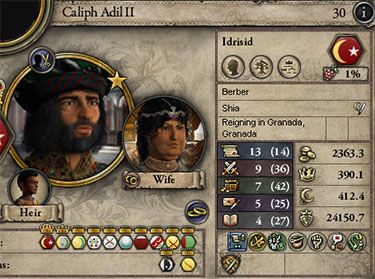
|
| By April of 959 things were quiet as the grumblings of his vassals remained only grumblings. At that point he began entertaining the idea of extending the faith to new peoples, but wasn’t sure which direction to move. He wasn’t prepared to take on France quite yet, and he didn’t have the naval strength to expedition further east in any practical way. Then one day a wise man visiting his court named Hashasheen told a story about the West Africans to the south and their strange ways. A smile crept across Adil’s face as he listened intently to the man. Within a month he had assembled his personal retinue together with both the Arab the Bedouin mercenary companies and headed south. Adil took command of the left, the talented Sheikh Amellal of Rosello was in the center and Sheik Badda of Caceres took the right, where the bulk of the cavalry was organized. An invasion of Mali on High Chief Birama was declared on February 1 of 960. After taking Timbuktu, a decisive battle was forced in Oualata where the Caliph’s cavalry chased down and eliminated the last of Birama’s army. Birama surrendered all of his territory on April 5th of 961. This was followed by a brief holy war for Gurma in June, and Songhay in September. That Songhay war was interrupted by the wise choice of High Chief Kassa of Songhay to convert to Shia Islam. A month later another war was declared to subjugate him, which took place rapidly. | |
With the Caliph and his army half a world away, 15,000 Andalusians declared independence right in Grenada, Adil's capital holding. Soon after a significant peasant revolt erupted in Valladolid. It was not until the Caliph’s army returned home that both were extinguished in February of 964. By that time Caliph Adil had proved himself both on and off the battlefield, and his vassals seemed pleased. In the years that followed Adil committed himself to matters of state, such as adjudicating disputes between his vassals. During this time he popularly became known as Adil ‘The Wise’, an epithet that he greatly appreciated. (In part he liked having it to help differentiate himself from his unpopular grandfather of the same name.) True to his nickname, Adil went on to found five universities during his rule. Around this time his son Tabat came of age, asked for and was awarded the post of Grand Vizier. In November of 965 Asturias had a major internal revolt and Adil jumped on the opportunity to claim more of Hispania. He declared war on Duke Flain of Portucale for his duchy, which was surrendered in in August of 966. Adil then declared war on Countess Benita of Coruna, another rebel. Meanwhile Asturias continued to disintegrate. Once Adil’s truce had expired he assisted that process by claiming another of their counties. By April of 968 the King of Asturias was reduced to a single holding: the County of Santiago. Other than the occasional Catholic revolt, the ensuing years were peaceful. During this time Adil’s thoughts continually were drawn back to his time in Mecca and Medina. He could not help but think it would be wondrous to incorporate them in his realm, somehow. After conferring with his son and other counselors he decided to make a move that might someday allow that to happen in the future. He planned to annex Emirate of Tripolitania in Africa, which would bring the realm one step closer to the holy places. The Emirate was nominally part of the Sultanate of Egypt, but Emir Anthinos Ismailid II was presently revolting against his liege. In March of 971 a holy war was declared. Ismailid surrendered his lands to Mauretania by the end of the year. Then, in 974, Prince Keraja, Adil’s second son, was caught plotting to kill his older brother. Enraged, Adil attempted to imprison him but failed. The 20-year old claimant fled to Persia. | 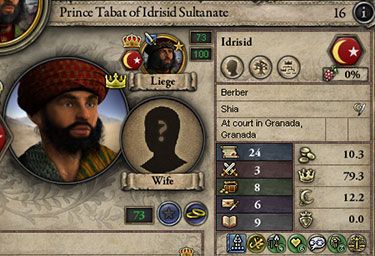
|

| 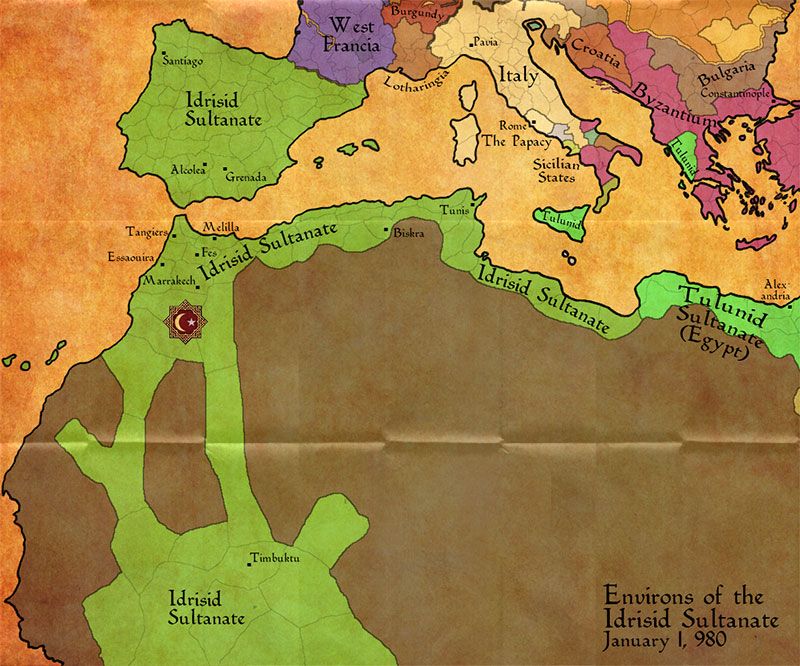
|

In 977, at 51 years of age, Adil declared one final holy war for what remained of Asturias – the final conquest of Christian controlled land in Hispania. Unfortunately the war was interrupted by a serious Catholic revolt on the other side of the realm which delayed its conclusion. Also during this critical time, word was received that Prince Keraja was hiring an army to claim the Caliphate for himself. It grieved Adil to order the assassination, but it had to be done. His son Keraja died in Persia from the assassin’s dagger, and his body was burned in a ditch. Adil never heard the news, however, as he died fighting from horseback that same day in the final battle against Asturias. He was 53. His remains were returned to Grenada and given a martyr’s funeral following the completion of the war under the leadership of his son, the new Caliph Tabat. Although he did not shy from the battlefield, and ultimately perished on one, it was Adil’s attention to administration and domestic matters that set him apart from his forebears. Though he did expand his realm, his greatest accomplishment may well have been simply holding it all together without any internal bloodshed. Another significant achievement was that that for perhaps the first time, under him all of the traditional lands of the Berber people had been united. Adil passed on a large and stable nation to his son, who hopefully would prove up to the same task. | 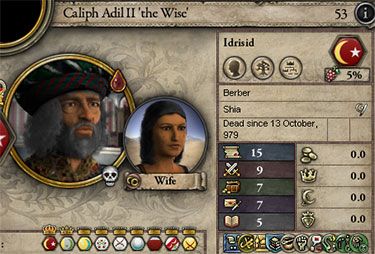
|
Last edited:
By April of 959 things were quiet as the grumblings of his vassals remained only grumblings. At that point he began entertaining the idea of extending the faith to new peoples, but wasn’t sure which direction to move. He wasn’t prepared to take on France quite yet, and he didn’t have the naval strength to expedition further east in any practical way. Then one day a wise man visiting his court named Hashasheen told a story about the West Africans to the south and their strange ways. A smile crept across Adil’s face as he listened intently to the man.
Cheers for the name drop.
And damn, you're holding down over half a dozen kingdoms in your Sultanate. Surprised you haven't had to deal with an independence revolt yet.
http://s836.photobucket.com/user/tinman01832/media/CK2AAR-3/IronmanQuestion800_zpsab2d22a6.jpg.html
Anytime, thanks for the great tip! I haven’t ever gone down that way before and I’m glad I did. I have lots of cultural independence revolts, for whatever that's worth. If I'm not already at war and the revolutionaries are smaller in number than my retinue I often don't mention it since it may not be terribly interesting. I did have one Andalusian revolt of 15k - that was interesting to be sure. (At the time, 15k would have made the revolutionaries the third largest army in the world.) I have only had pathetic West African religious revolts, a few small Ibadi ones, but no Sunni ones. That I find pretty strange myself. It's the faction independence and crown authority wars that I dread and am sure to have sooner or later. I suspect that people who read AARs are generally very familiar with the game. But for the sake of anyone reading who isn’t, here’s how I try to avoid them:
I encourage anyone to chime in with their own ideas or counter-suggestions if they like. I am always interested to hear how others make large countries work. Thanks! |
Last edited:
Lots of updates over the weekend. You've amassed quite the empire, even if you haven't claimed the title yet.
| January 1, 980: Eastern ambitions | |

Once Asturias had been annexed the following months of Caliph Tabat’s rule proceeded uneventfully. Vassal factions against him and his laws were minor, thanks to his impressive personal diplomacy and the granting of several favors and gifts. He conducted his Hajj, as tradition dictated, and by July felt confident to begin expanding his realm and faith. As Shia Caliph, he saw this as his sacred duty – one that he took very seriously. During his father’s reign the port cities of the realm had expanded rapidly. Their combined fleets at latest consensus totaled around 300 galleys. With this armada he could he could easily transport the bulk of his retinue and levies if need be. With this fact in mind, he poured over his maps with hungry eyes. His father and he shared the dream that one day Mecca and Medina might somehow become part of the realm, or at least liberated within Shia nations. At present this was still a distant fantasy. Practically speaking, Caliph Tabat would need to have a border with an Arabian province in order to attempt to subjugate Arabia, or hold land in the Emirate of Arabia in order to declare a holy war for the Emirate of Medina. Both of these seemed to be highly unlikely in the near future. His counselors and he discussed the matter late one warm July evening in the palace gardens. The group agreed that Egypt was the stepping stone to Arabia and needed to be incorporated into the realm, at least long enough to convert the land to the Shia faith. The question at hand then became how, exactly, to wrest control of Egypt without prosecuting a war against the entire Sunni faith on the far side of the world. Sheikh Amin of Mahdia, Tabat’s talented and aged spymaster had an idea. “We could call for a subjugation of Tulunid Egypt, which would not necessarily have religious overtones. As long as Caliph Shabibid of Arabia [leader of The Arabian Empire] and the Tulinids remain hostile to one another, we could likely complete that process in your lifetime. As a matter of fact Shabibid is trying to subjugate Egypt himself as we speak. If we could ally with Egypt and help them survive, then in the future we could turn on them. When we do, their former enemies – The Shababids – would be unlikely to assist.” Tabat’s Grand Vizier, Shiek Sanyo of Mursiya, interjected with a raised finger. “The Sultan of Egypt, Hakam the Great, will not marry a close relative of yours. It would be unseemly for him as a Sunni head of state. However…” he added with a sly glance,” his son and heir, Emir Abdul-Haq, could and would. Such an alliance may allow us to side with Egypt, and help them to withstand the Arabian onslaught.” Tabat’s 57-year old Marshal, Wali Hashim of Baeza, wore an expression of outrage. Plotting such as this was beneath him, and he felt should be beneath the Caliph as well. Be that as it may, he lodged some practical objections rather than moral ones. “If we do this, and get called, that means we would be honor bound to send troops. Egypt is not as strong as they used to be. And even with our help there is still a good chance they will fall. If that happens then we will have gained nothing, and indeed may very well plant future claimants within a massive Arabian Empire. Also, Emir Abdul-Haq may take the marriage for his own nefarious purposes and never call us at all! Furthermore I don’t need to remind the Caliph how dangerous it would be to transport our armies so far from home, when the French are eagerly awaiting the chance to retake Barcelona.” A half-smile curled on the Caliph’s lips as considered his options. He loved the idea of driving the wedge between the two major Sunni powers even deeper and decided it was worth the risk. “Go to Egypt, bring my half-sister, Princess Zaghwa and some gold with you. Make the match, and convince Hakam we are his friends,” he said to his Grand Vizier. “And send for representatives of the Berber, Arab and Tureg companies,” he said to Wali Hashim, “they shall do our fighting for us, if need be.” Unfortunately their great schemes came to naught. Despite being on the best of relations with Caliph Tabat, Sultan Hakam would not call the Mauretanians to the fight. They lost control of Egypt in July of 981, and both he and his son were banished to their holdings in Sicily. Egypt was now part of the Arabian Empire, which was a serious setback to Caliph Tabat’s vision of the future. His grand plans would need to wait. | 
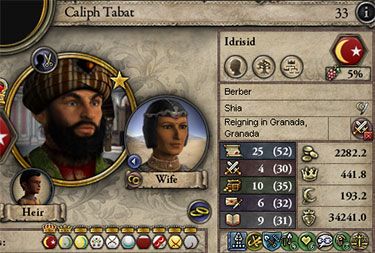
Caliph Tabat in 980 after assuming leadership of the Caliphate. |
| This turn of events filled the Caliph with rage. Although he had been previously known for his kind nature, his disposition changed completely during this period. Tabat chose to lash out at his kinsman Iken, Sheikh of Coruna, as the two men had always hated each other. Tabat sent his men to arrest Iken who, in turn, evaded them and revolted. By November 13th of 981 he was in Tabat’s dungeon with his Sheikhdom removed from him. Unsated, Tabat then declared a holy war on Duke Orso of Capua, a minor Christian landholder in Sicily, for the island of Malta. While besieging Malta, Ironically Sultan Hakam ‘The Great’ (the displaced Sultan of Egypt) then called on Tabat for assistance with a small local revolt. “Now!?!” Tabak shouted at his grand vizier. “Now they want help? To defeat one Emir!” Prince Adil, Tabat’s heir, came of age in 983 in the middle of these conflicts. Unfortunately for him his father’s rage was insatiable at that time. The young man was deemed unfit to rule, and the Caliph had his eldest son quietly assassinated. Caliph Tabat had little time to consider his brutal action before crisis struck. In June of 983 Caliph Shabibid of Arabia declared war on him. Now that the Arabians held Egypt, they wanted Africa, too. This wasn’t a holy war for Tripolitania – this was an invasion for all of Central North Africa itself. There was blood in Tabat’s eyes as he ordered all his vassals to arms. “And mercenaries! Hire them! Hire them all!” The first real test of the Caliph’s mettle as a ruler had begun. | 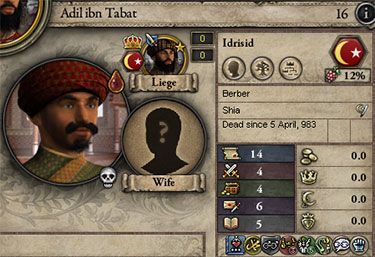
Prince Adil, Caliph Tabat's eldest son, who was assassinated by his own father. Ultimately this brutal move led to the next Caliph to be underage, and would result in serious succession problems. |
| June 15, 983: Arabian onslaught | |

Tabat and his military advisors rounded up every mercenary company they could and called them to Grenada, along with every ship they could muster. Within a month he had loaded them, his retinue, and all the vassal levies he could get his hands on – 16,000 in total – on onto the assembled fleet and sailed for Africa. The fleet was ordered to Leptis Manga where the army was told to wait for the enemy. Meanwhile the rest of Tabat’s levies were ordered to march to Tunis. Marshal Hashim insisted that the Caliph, who was one of the army commanders in Leptis Manga, remain calm and wait as the days ticked away without any sign of the enemy. “They are coming”, his marshal assured the Caliph, and time was on their side. Every day that passed without combat brought the Caliph closer to victory. This was a concept that didn’t make much sense to the Caliph, but he trusted and waited. On November 30th the unexpected happened. Caliph Shabibid landed 4,000 men in Kabylia, west of Tunis. There they encountered small bands of levies that were completely unprepared for an attack so deep in friendly territory. When Tabat heard the news he wanted to race there but Hashim convinced him it was a diversion. Ultimately the Marshal was proved correct. In December an army of 7,000 Arabians arrived east of Leptis Manga and began besieging the Mauretanian fortress of Syrte. Tabat ordered his larger force to meet them, which they did at the Battle of Syrte. The conflict was a slaughter, as almost six thousand of their enemy fell there at the cost of 1,800 Mauretanians. The Arabian remnants were summarily pursued and wiped out to a man. | |
Meanwhile, the swirling pitched battles along Kabylia’s dusty coastal plains became more interesting when 7,000 more Arabians appeared in April of 984. Again, Hashim convinced his Caliph to stay in Cental Africa and allow the levies in the region to deal with the incursion. Around that time Prince Keraja, Tabat’s second son and heir, came of age and joined his father at the front. By early July of 984 the remnants of the Arabian forces in Kabylia had been routed to Constantine in the mountains where Tabat’s levies finished them off. When Tabat heard this, he sensed the tide had turned. He could not be dissuaded from ordering his army forward to Senoussi in Egypt. The bloody Battle of Tazirbu followed, which the Mauretanians won by a narrow margin before pursuing their enemy to Benghazi. Following the Arabian surrender, Tabat’s forces began besieging multiple holdings in Cyrenaica. Caliph Tabat’s fortunes became secured with Caliph Abrahim III of Arabia died, leaving the realm to his sixteen year old son, Khalil. Overnight a massive movement formed against him which included many of Egypt’s landholders. They and many others in the realm were granted independence overnight. When Tabat heard the news he could barely believe his luck. The war was almost his, and after it was over he would have little trouble annexing these small independent states into his realm. On May 11, 986, Caliph Khalil surrendered his vain attempt for Africa, which sparked celebrations across the wide extent of Mauretania. Everywhere, that is, except Calph Tabat’s encampment in Syrte. Instead, he and his advisors were planning a series of holy wars that would culminate in the annexation of Egypt itself, to begin after the following new year. These ambitious plans were aided by the escalating disintegration of the Arabian Empire. Malta, which had been under siege for years, was finally surrendered in January of 986, which coincided with the start of Tabat’s Egyptian campaign. | 
|
| January 21, 986: The Egyptian Gambit | |

Tabat opened his bid for Egypt with a holy war on Emir Anthinos for Cyrenaica in January of 986. Leaving his levies at rest, he attacked with a 9,200-man army consisting of mercenaries and skirmishers from his personal retinue, leaving 4,500 men of his cavalry retinue in reserve. Tabat’s cavalrymen had long given up their traditional camel mounts for rugged Andalusian chargers, which over time were able to acclimate to the harsh conditions in Egypt. They would serve him well in the coming months, but were not needed to defeat Cyrenaica, which could only mount limited resistance. The war for Cyrenaica was successfully concluded on July 31. Princess Zaghawa, Caliph Tabat’s half-sister who was married to Emir Biktor Tulunid of Egypt, died in childbirth the previous year. This left the Tulunids without any claims on Tabat’s titles, or an alliance with Tabat either. Biktor, who had claimed Tobruk amid the chaos that had engulfed the Arabian Empire, was Tabat’s next target. Tobruk was surrendered on April 19 of 988 after a series of running battles across the desert. As chaos continued to reign in Arabia, Caliph Tabat decided to press his luck on May 24th of that year by declaring simultaneous holy wars for both the independent sheikdom of Gizeh (in the Emirate of Alexandra) and independent Absialomid Emirate (the Damiettan territory in the north of the Nile delta). The Calpih personally joined the smaller force heading for Gizeh while the main body of his troops led by Sheikh Masgava of Fes marched on Damietta. During the conflict the people of the Duchy of Kabylia celebrated one hundred years of Mauretanian rule. For all practical purposes they then considered themselves part of the Sultanate of Mauretania, which pleased the Caliph. Back in Egypt, Gizeh surrendered in July of 989 and Damietta did as well by the end of that November. At that point Tabat controlled more than a third of de jure Egypt. This was an accomplishment that surprised everyone including Tabat himself, who considered ceasing his eastward expansion in order to consolidate his realm. Any notions of peace were short lived, however, when a second succession crisis flared up on the Arabian Caliph Jalil, who was already struggling to deal with his first. Drunk with victory, obsessed with conquest, and against the advice of his counselors, Caliph Tabat declared a subjugation war on the Arabian Caliph for all of his Egyptian holdings on January 1st of 990. Tabat’s opening move was to send a 10,000 man army of his retinues and mercenaries under Sheikh Masgava south to relieve the siege of Aswan. Aswan was rebelling against Caliph Jalil, and Tabat resolved to help any enemy of his enemy. The Arabians were met at the Battle of Qasr Ibrim, where all 2,300 of them were ushered off to paradise at the loss of only 36 Mauretanian mercenaries. The victorious army moved north, bypassing the army of Emir Bishoi, one of the Arabian rebels. At the same time a smaller force of 7,000, which included Caiph Tabat on the left flank, headed west to besiege the more venerable holdings in Alexandra and Cyrenaica. They were later joined by the Caliph’s personal levies who arrived by ship. As before, all of Tabat’s vassals’ levies were left at home in reserve, primarily to deal with any French incursion that might take place while the army was engaged in Egypt. Things became interesting in March 990. A 10,500-man enemy army was seen exiting the Sinai towards the large Mauretanian army under Sheikh Masgava. As had been planned in advance, Masgava moved his troops into the heart of the delta near Manusura to wait for reinforcements. As soon as he found out about the massive impending battle, Caliph Tabat ordered all sieges be abandoned so that his armies could converge on Manusura. | 
|
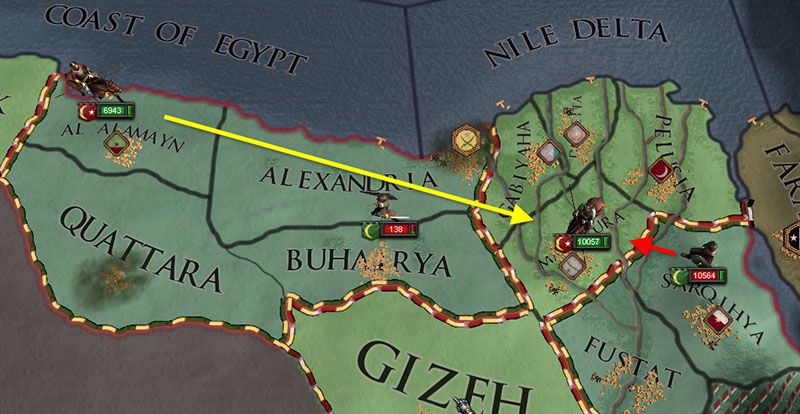
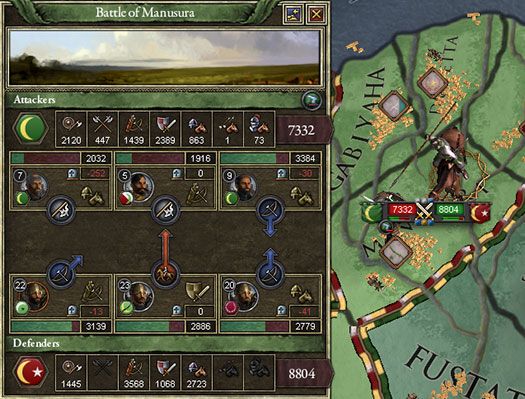
|
|
The Battle of Manusura ensued, carnage of which was unlike anything in living memory. At the start of the third day things looked bleak for the Mauretanians who had lost more 2,700 men and continued to bleed at a faster rate than their enemy. With morale suffering, Masgava was on the verge of ordering a retreat when Wali Keraja of Baeza on the left flank pulled off a miracle. The Arabians in their overconfidence were utterly surprised and overwhelmed by the audacity of the Mauretanian cavalry they faced. As a result the larger Arabian force, poorly led and inadequately prepared, collapsed and routed. Racing across the desert at full speed, Caliph Tabat arrived at the battlefield with his army shortly thereafter, missing the end of the battle by hours. Determined to not miss the next one, he took command both of his armies and led the pursuit to Fustat, where Jalil’s remnants were obliterated. In all, 10,500 enemy troops had been dispatched at the combined loss 3,000 of Tabat’s men. Prince Abdullah, the third of Jalil’s four sons, was also captured in the process. The victory was so exhilarating that afterward his men hoisted Tabat up on their shoulders and began chanting “Tabat-The-Great” over and over. The epithet took hold, and from that day forth he was known as such. The Battle of Suez in October led to the defeat of another 2,900 men at the loss of only 139. On September 15th of the following year Jalil had had enough and surrendered all of his lands in Egypt. At that point Caliph Tabat ‘The Great’ controlled all of Egypt west of the Sinai except for Aswan, which was still rebelling against Caliph Jalil. Tabat immediately declared a holy war for Aswan, which was completed in January 12, 992. The Sinai was incorporated as well by the end of that August. Tabat’s long range plan for the region was to use Egypt as a springboard into Arabia, which would later allow him to claim the holy sites in the Emirate of Medina. At that point he planned to release Egypt as he suspected it would be too troublesome to control. Tabat’s loyal cousin, Prince Muhammad, was made emir of Sinai and granted Aswan and Malta as well. In discussions with Muhammad, Tabat explained that he planned to eventually release Egypt with Muhammad as its Sultan, once the region had recovered from all of its recent wars. Needless to say Muhammad was ecstatic. To Tabat’s great surprise, within a year every single Sunni leader in Egypt had converted to Shia – many without even being asked to. He wondered if perhaps it would be possible to hold Egypt after all. The promises made to Muhammad would turn out to be empty ones, which would fall on Tabat’s grandson to rectify. Caliph Tabat’s dream of annexing Mecca and Medina into his realm seemed only a breath away – which in and of itself was an impressive achievement. Tabat was convinced by his counselors, however, to honor his truce and not attack Arabia as he desperately wanted to. Instead the Caliph focused his attention on securing the lands he had recently conquered. In October in 993 Tabat assumed the Sultan of Egypt title, usurping it from Hakam the Great, who still was hanging onto holdings in Sicily and Arabia. This was noteworthy as it was only the second Sultan title ever held by any Sultan of Mauretania, even though there were eight de jure Sultanates currently within the realm. A period of peace followed for Mauretania. Arabia, meanwhile, continued its long and painful death spiral as revolution after revolution took place in rapid succession. To make sure these troubles did not spill over his borders, Tabat continued the service of the four mercenary companies that had served him so well, posting all of them in Egypt. Similar to Kabalya, Seville was incorporated into the Sultanate of Mauretania on 1 January 995. Caliph Jalil ‘The Unready’ of Arabia died in 995. The next round of succession crises left Abdullah Abbasid II on the throne of the Caliphate. He reigned for less than two years until he was deposed by a decadence revolt in 997. During that revolt Tabat decided to declare war on him for the Shiekdom of Al’Akbah, once again against the pleading of his councilors. Unfortunately Tabat died in August while the campaign was far from complete. As a result he bequeathed his massive nation to an unprepared 12-year old grandson, Tabat II, while it was heavily engaged in a foreign war. His death was a national tragedy, and his funeral was the most elaborate one held in Mauretania in many years. Later his remains would be reinterred under a grand monument in Grenada erected by his grandson, Tabat II. Sultan Tabat ‘The Great’ was an interesting study in contrasts. He was quite skilled in the art of diplomacy, but chose to invade his neighbors as soon as talk to them. He was a mediocre commander who spent nearly his entire life leading men in battle. He was an amateur in the realm of intrigue that loved to hatch complex plans, but which usually came to naught. Yet despite these quirks and shortcomings, he managed to hold his massive nation together long enough to wrest Egypt from the Tulunids and Arabia. This was no small feat, as these were the second and third most powerful nations in the world when he became Caliph. Unlike his immediate forebears, Tabat was reckless and impulsive. Thanks to the upheaval that had rocked Arabia in his day, however, those liabilities served him well. If Tabat earned his epithet of ‘The Great’, it was not because of exceptional administrative or military skill. Rather it would be because of his innate ability to read the political winds and the audacity to do what some deemed impossible. For those reasons, his soldiers loved him like a father, and he would be venerated for generations to come as ‘The Great One’. In the end, Tabat was the living embodiment of the old adage that fortune can indeed favor the bold. |
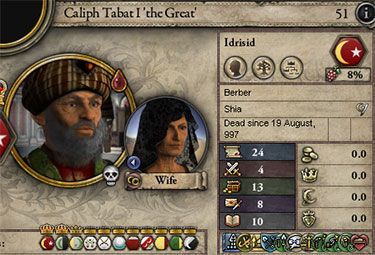
Caliph Tabat 'The Great' at his death in 997. |
|
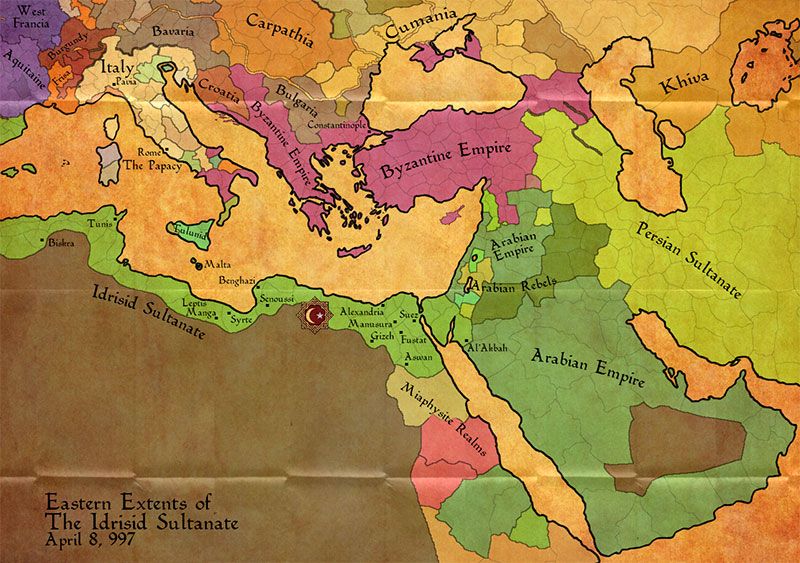
Last edited:
Impressive conquests, though the notion of releasing Egypt later is probably a good one.


